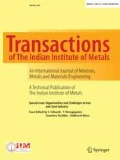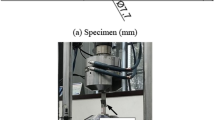Abstract
In this study, the effects of electrode clamping force on the fatigue strength of 5083-0 aluminum alloy spot-welded joints have been investigated via experimental and multiaxial fatigue analysis. To do so, three sets of the specimens—with different amounts of the sheet spacing—which have been fabricated using different values of the electrode clamping force, were selected, and then fatigue tests were performed under various cyclic longitudinal load levels. A nonlinear finite element code was used to obtain the stress and strain distribution near the roots of the nuggets as a result of longitudinal applied loads. Fatigue lives of the specimens were estimated with Crossland, Kandil–Brown–Miller, Glinka, Varvani-Farahani, Fatemi–Socie, and Smith–Watson–Topper multiaxial fatigue criteria by means of the local stress and strain distribution obtained from the finite element analysis. It was shown that, the fatigue lives of spot-welded joints were improved by increasing the electrode clamping force. Also, the comparison between experimental results and multiaxial fatigue predictions revealed that among the applied criteria, the Crossland and Glinka approaches had the best accuracy for all types of the specimens.











Similar content being viewed by others
References
Long X, and Khanna S K, Int J Fatigue 29 (2007) 879.
Spitsen R, Kim D, Flinn B, Ramulu M, and Easterbrook E T, J Manuf Sci Eng 127 (2005) 718.
Sun X, Stephens E, Davies R W, Khaleel M A, and Spinella D J, Weld J 83 (2004) 308.
Chang B H, and Zhou Y, J Mater Process Technol 139 (2003) 635.
Ni K, and Mahadevan S, Int J Fatigue 26 (2004) 763.
Adib H, Gilgert J, and Pluvinage G, Int J Fatigue 26 (2004) 81.
Hassanifard S, Zehsaz M, and Esmaeili F, J Comput Methods Eng 32 (2012) 15.
Papadopoulos I V, Davoli P, Grola C, Filippini M, and Bernasconi A, Int J Fatigue 19 (1997) 219.
Brown M W, and Miller K J, ASTM STP 770 (1982) 482.
You B R, and Lee S B, Int J Fatigue 18 (1996) 235.
Macha E, and Sonsino C M, Fatigue Fract Eng Mater Struct 22 (1999) 1053.
Wang Y Y, and Yao W X, Int J Fatigue 26 (2004) 17.
Shamsael N, and Fatemi A, Fatigue Fract Eng Mater Struct 32 (2009) 631.
Findley W N, J Eng Ind Trans ASME 81 (1959) 301.
Susmel L, and Lazzarin P, Fatigue Fract Eng Mater Struct 25 (2002) 63.
McDiarmid D L, Fatigue Fract Eng Mater Struct 14 (1991) 429.
Crossland B, Effect of large hydrostatic pressures on the torsional fatigue strength of an alloy steel, Published on Conference: International Conference on Fatigue of Metals, Institution of Mechanical Engineers, London (1956).
Brown M W, and Miller K J, Proc Inst Mech Eng 187 (1973) 745.
Fatemi A, and Socie D F, Fatigue Fract Eng Mater Struct 11 (1988) 149.
Li J, Zhang Z P, Sun Q, Li C W, and Qiao Y J, Int J Fatigue 31 (2009) 776.
Wang CH, and Brown M W, Fatigue Fract Eng Mater Struct 16 (1993) 1285.
Smith RN, Watson P, and Topper TH, J Mater 5 (1970) 767.
Glinka G, Shen G, and Plumtree A, Fatigue Fract Eng Mater Struct 18 (1995) 37.
Varvani-Farahani A, Int J Fatigue 22 (2000) 295.
Socie D, J Eng Mater Tech 109 (1987) 293.
Liu K C, ASTM STP 1191 (1993) 67.
Chu C C, Conle F A, and Bonnen J J, ASTM STP 1191 (1993) 37.
Mroz Z, J Mech Phys Solids 15 (1967) 163.
Swanson Analysis Systems Inc., ANSYS, Release 11 (2007).
Swanson Analysis Systems Inc., ANSYS, User’s Guide for Revision 11, ANSYS 9 Documentation, ANSYS Element Reference, Part I: Element Library, SOLID95 (2007).
Higashida Y J, Burk D, and Lawrence F V, Weld J 57 (1978) 334.
Author information
Authors and Affiliations
Corresponding author
Rights and permissions
About this article
Cite this article
Mokhtari, H., Esmaeili, F. & Dabbagh-Yarishah, J. Fatigue Life Estimation of Spot-Welded Joints Using Several Multiaxial Fatigue Criteria. Trans Indian Inst Met 69, 1595–1603 (2016). https://doi.org/10.1007/s12666-015-0735-1
Received:
Accepted:
Published:
Issue Date:
DOI: https://doi.org/10.1007/s12666-015-0735-1




